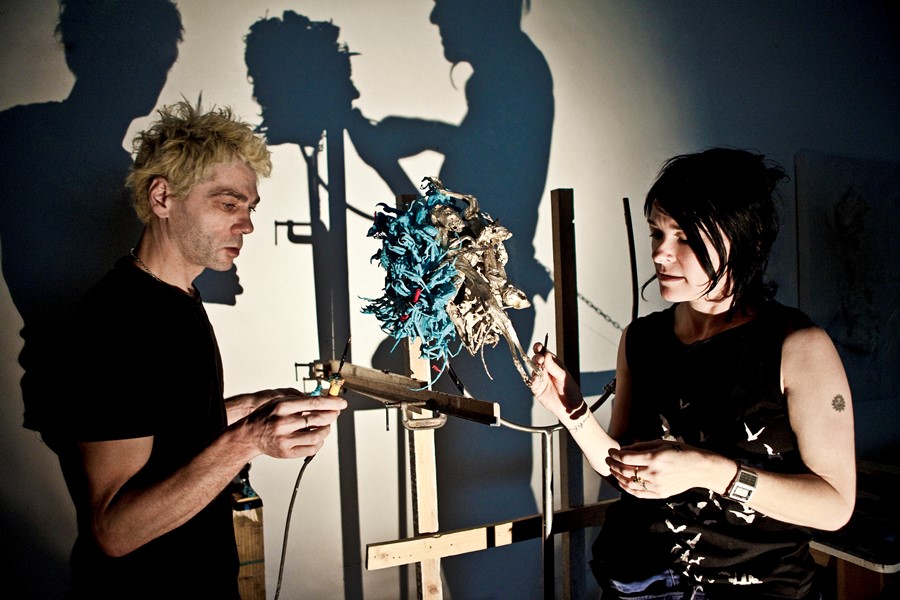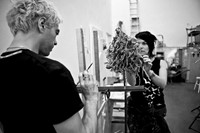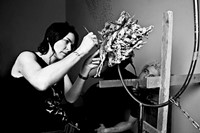Artist couple Tim Noble & Sue Webster are best known for their ‘shadow sculptures’– towering structures that blend discarded rubbish, animals and other matter to create shadow portraits of the two.
Artist couple Tim Noble & Sue Webster are best known for their ‘shadow sculptures’ – towering structures that blend discarded rubbish, animals and other matter to create shadow portraits of the two. Their work also includes pop art light sculptures, pieces which have successfully elevated crass kitsch iconography to high art status. Noble & Webster’s latest project, Turning the Seventh Corner, draws on these and other practices to staggering effect. Created for Blain | Southern’s brand new Berlin gallery – a concrete, steel and glass structure with a floor space of more than 1,300 sq metres – the site-specific installation is monumental in both scale and ambition. Inspired by the tombs of the Egyptian Pharaohs in collaboration with the acclaimed architect David Adjaye, the artists desire for an element of surprise has led them to hold back on revealing every detail of the work, which they have created as a journey of exploration.
AnOther spoke with Sue Webster to find out more.
Blain/Southern’s gallery space was formally the printing press of the liberal German newspaper Der Tagesspiegel. Did the building’s history inform your installation in any way?
We were lucky that at the same time we were cultivating the concept for our show in Berlin, the gallery was searching for new premises and were therefore entirely open to making their decision based on our ever-expanding needs. Our requirements moved the scale from that of a normal shop window-type space into the disused printing factory of the German Newspaper Der Tagesspiegel, which happened to be in Potsdamer Strasse, a location away from the obvious art district. We were also very inspired by the Newspaper’s motto "Rerum cognoscere causas" – "To know the causes of things". It kind of reminds me of the wrought iron sign that hangs outside of Auschwitz that reads "Arbeit Macht Frei" – "Work makes one free".
The piece is inspired by Egyptian Pharaohs, where did this interest come from?
An artist's brain is like one giant creative sponge that draws on every single experience which may seem meaningless to others. For instance, our latest installation takes as much of its influence from visiting the tomb of Tutankhamun as it does from the fatal search for hidden treasure depicted in the 1969 western McKenna's Gold.
The installation features a maze of tunnels that leads the viewer on a journey through the building – can they choose their own path or will you navigate them?
Upon entering a doorway on the second floor of the gallery, the visitor walks through a labyrinth of man-made tunnels, dimly lit with narrowing passages. Arranged over 20 square metres, these ascend and descend in a spiral-like manner and have been designed to disorientate; in doing so, the mind is steered towards a more open and meditative state, it's a transcendental walk. We feel that art is a religious experience therefore you want to free your mind of all previous thoughts. Inexorably, almost as if drawn by a magnetic force, the visitor is pulled into a burial chamber, which gently glows as the eponymous seventh corner is turned. It is within this chamber that our work will be revealed.
Can you give us any clues as to what we might find around ‘the seventh corner’?
After turning the Seventh Corner you may enter an intimate, darkened chamber, where before you stands a golden sculpture lit by a single source of light. The inquisitive eye may feast upon the exquisite detail of the sculpture – a delicious mass of entwined creatures, each cast in solid silver and plated in pure gold. A cast of dried frogs, dried baby rats, crows feet, a pair of vulture's feet with claws, a chicken's foot – and at the centre seemingly spewing out from the mass – an offering of two mummified squirrels.
This is the second time you’ve worked with David Adjaye – is this an easy collaboration?
It's actually the third time we've worked with David, firstly he designed our studio and living apartment when we bought a disused furniture factory in Shoreditch in 2001. The studio, which was later termed Dirty House, went on to become one of David's most seminal works and led him to greater projects such as designing and building his first museum in America – the Museum of Contemporary Art in Denver. As a thank you present, he commissioned Tim and I to build a giant outdoor sculpture, Toxic Schizophrenia-Hyper Version 2009. The idea to collaborate on Turning the Seventh Corner happened one night over dinner, Tim and I had just returned from Joshua Tree in California where some friends of ours had recently bought 80 acres of land and were interested in both David designing a house for them and Tim and I building a sculpture. We had the idea of burying a work underground, that was only accessible by travelling through a system of tunnels that would lead to a buried chamber and eventually to the actual work of art itself... unfortunately our Californian friends couldn't quite comprehend such a complex idea, one where the artwork was not always visible, I guess ultimately what they wanted was a talking point in their living room... which was fortunate for us, as this is what lead us to finally realise Turning the Seventh Corner, in Berlin.
Turning the Seventh Corner runs until 16 July 2011 at Blain/Southern, Berlin.
Text by Frankie Mathieson


